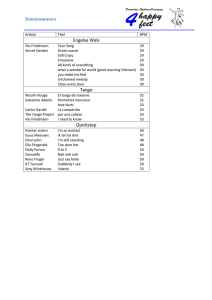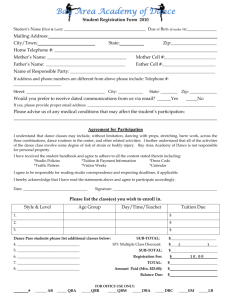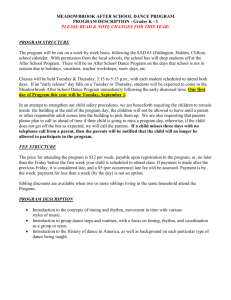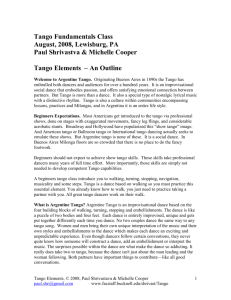Your adventure in Argentine Tango begins… and no doubt you have
advertisement
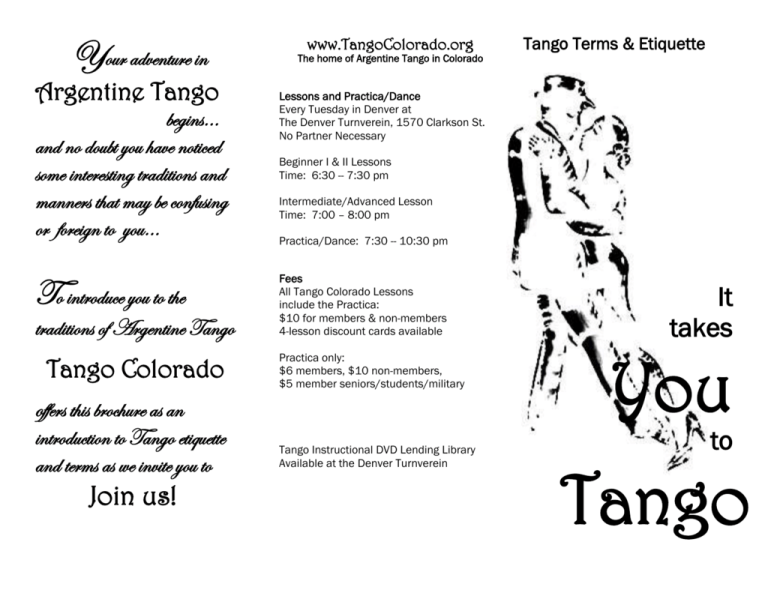
Your adventure in Argentine Tango begins… and no doubt you have noticed some interesting traditions and manners that may be confusing or foreign to you… To introduce you to the traditions of Argentine Tango Tango Colorado www.TangoColorado.org The home of Argentine Tango in Colorado Lessons and Practica/Dance Every Tuesday in Denver at The Denver Turnverein, 1570 Clarkson St. No Partner Necessary Beginner I & II Lessons Time: 6:30 -- 7:30 pm Intermediate/Advanced Lesson Time: 7:00 – 8:00 pm Practica/Dance: 7:30 -- 10:30 pm Fees All Tango Colorado Lessons include the Practica: $10 for members & non-members 4-lesson discount cards available Practica only: $6 members, $10 non-members, $5 member seniors/students/military offers this brochure as an introduction to Tango etiquette and terms as we invite you to Join us! Tango Terms & Etiquette Tango Instructional DVD Lending Library Available at the Denver Turnverein It takes You to Tango TANGO RHYTHYMS Tango: Generally 4/4 or 2/4 time Waltz (or Vals): Waltz rhythm, generally 3/4 time. Milonga: Usually fast, rhythmic, generally 2/4 time TANGO STYLES Milonguero-style tango: Commonly used to refer to the very close embrace style of dancing tango. Also referred to as club style or apilado style. Includes non-pivoting back ochos, and ocho cortados instead of front ochos. Salon-style tango: Generally considered to be open embrace, or an embrace that varies between open and close. Includes pivoting ochos, and grapevine turns. Fantasia (fantasy) or stage tango: Typically a flashier and more athletic version of salon style for performance. Not typically danced socially on a crowded floor. TANGO TERMS Adorno: Adornment, embellishment. Argentine Tango: a social dance that originated in Argentina and Uruguay. Argentine tango relies heavily on improvisation; although certain patterns of movement have been codified by instructors over the years as a device to instruct dancers, there is no "basic step." One of the few constants across all Argentine tango styles, is that the follower will usually be led to alternate feet. Another is that the follower rarely has her weight on both feet at the same time. Cabeceo: Asking someone to dance using eye contact. Cortina or curtain: A short period of non-tango music between tandas giving dancers time for conversation and to escort the lady back to her seat. Crossed Feet: Occurs whenever the couple is stepping together on his and her right feet and then on his and her left feet, regardless of direction. The opposite of parallel feet. Giro: Turn. Milonga: This term has two meanings: 1) a type of Argentine tango music, usually fast, playful, and rhythmic; or 2) a tango dance event, as in “going to a milonga”. Parallel feet: The natural condition when a couple dances in an embrace facing each other, the man stepping on his left, the lady on her right foot, and then the man stepping on his right, the lady on her left foot, regardless of direction. The opposite of crossed feet. Practica: A practice. Steps: Some of the more common “steps” in Tango: Amague (a decorative leg movement) Colgada (a mutual axis spin), Cruzada (Cross), Gancho (leg hook), Molinete (grapevine), Ocho (a figure eight leg movement), Ocho Cortado (a turn), Sacada (stepping into a vacated space of the partner), Volcada (an off axis leg sweep), Voleo or Boleo (a swivel), Tanda: A set of tangos, waltzes, or milongas, typically three or four grouped together, generally music of the same style/rhythm or orchestra. Traspie: A walking step with a syncopated cross step. ¿Uno mas? Literally means “One more?” as in “Will you dance one more with me?” TANGO ETIQUETTE Asking someone to dance by cabeceo: The charming and old fashioned way of asking someone to dance in Buenos Aires, whether you are a man or a woman, is to let your gaze rest on the person you want. Whether they are far across the room, a friend or a stranger, when you catch each other's eyes, that's the invitation. A nod and a smile, perhaps a glance toward the dance floor, is confirmation. In the United States, asking is also done verbally. Dance Floor Courtesy: It is the leader’s responsibility to navigate in the line of dance and keep a watchful eye to avoid collisions. Do move with the flow and do not execute back steps into the line of dance behind you. No matter how aware we are of those around us on the dance floor, collisions do occasionally occur. Should a collision occur, it is considered good dance floor etiquette to make a short apology. Line of dance: Tango is danced around the edge of the dance floor, counter clockwise, generally in one lane, but there can be more than one lane if the floor is more crowded. Normally you keep dancing behind the couple in front of you and do not pass or cut across the floor. It is considered bad form to move or travel against the line of dance. Entering the Line of Dance: Please be aware that the line of dance is moving on the outside lane as you step into the line. Wait for a slight break in the line and be courteous to the couple coming up behind you. Frequently there are only one or two places where couples enter the dance floor so be aware of everyone around you. Make your partner’s experience the best possible; please do not teach or “help” unless requested: This is an important point, generating the most frequent complaints. It is very poor etiquette to ever teach anyone during a milonga (social tango dance event). Teaching on a social dance floor interrupts the line of dance. If your partner is open to suggestions, please move to a practice area. At practicas, only a few find it acceptable to offer suggestions, or constructive criticism. UNLESS YOU RECEIVE A CLEAR REQUEST, ASSUME THAT ADVICE AND TEACHING ARE NOT WELCOME. Lead vocabulary your partner knows, within her ability to easily follow. Tango is complex and has many styles, so take care not to make people feel bad about their dancing. Advice or teaching is often heard as criticism. Respect the space of those on the dance floor if you are not dancing: At the Turnverein practica, the south side is for practice. Expect people to dance in place or stop and start. You should also leave room for those working by themselves. The north side is line of dance. People on the north side should not create obstacles to the moving dancers. Walk in the aisles behind the tables, not on the dance floor. If you are not dancing, show respect to those who are by not walking through the busy dance floor and by staying clear of the dance space. Dancers have the right-of-way! Safety: Your safety and enjoyment is important to our tango community. Go to any TC officer or the host with any social, etiquette or safety concerns. It is perfectly appropriate for a female alone to ask to be escorted to her car. Saying “thank you” too soon: Saying “thank you” after one dance or song means you are finished dancing with that person, or don’t want to dance with them anymore. So, don’t say thank you too early! Please remember that it is traditional to dance a tanda (set) with one partner before changing to another. After a tanda it is appropriate to say thank you.





